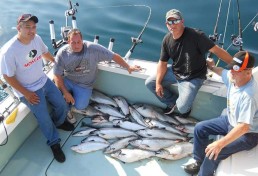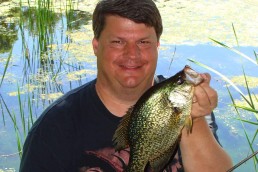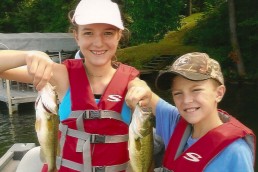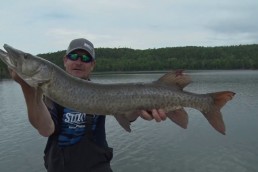Think ‘Mixed Bag’ for Late-summer Action
SHARE THIS POST
Every year we deal with warmer water in August. And this year is no exception. Spring came early too, and made for some fantastic fishing with lots of lake trout early followed closely by an abundant supply of acrobatic steelhead and aggressive, well-fed king salmon.
Sounds like a fairy tale start to a prolonged great season, right? Not so, once that heat of summer rolls around. What can we expect during these long hot days when surface temperatures creep up into the 70s and beyond and we find the water temperatures reaching into depths of 70, 80 and even 100 feet down?
The warm water will defiantly slow the fishing near the shore, but there are options. In these situations, I like to change up my tactics and head for the depths. Depending on where you are fishing on the lake, certain winds and currents will either bring you warm or cool water. In my area, north winds and a north current will pull warm water in and slow any nearshore fishing.
When the water warms toward the shore, kings become less active. And apart from the occasional dawn or dusk fish, we need to look elsewhere to fill the cooler. That generally means deeper water and diversifying your attack to target several species rather than just the salmon. Because salmon primarily feed up and look for alewives cruising the thermoclines during warm-water periods, the baitfish are often moving to deeper water and hugging the bottom to stay in the coolest water. This is not a place where the chinook salmon will often look for their meal. And, the kings will scatter in search of pods of bait, making them much harder to find and target.
Steelhead and lake trout will adapt easier and quicker to warmer water. Steelhead will roam the higher water column in search of food and often find and settle in small temperature breaks on the surface, feeding on bugs on the top of the water. Lake trout will also roam the surface area feeding at times, but often are found in their favorite spots, one being the bottom, where the coolest water is found. Food for the trout can be the alewives that find the bottom levels appealing too, but the trout, unlike salmon, will adapt and change food sources. Most lake trout I clean this time of year will be full of the round gobies that have become fairly abundant on a lake’s bottom.
Targeting these two species is fairly easy and can yield the occasional salmon. Lake trout, being the most predictable and the most abundant, will often be the easier of the two. They like the sandier bottom areas that are flat and hold bait. Enticing the trout to bite requires a slower presentation, and I like to break out the old-school Luhr-Jenson OO Dodgers in Chrome and some Spin-n-Glows. Lakers seem to prefer yellow, orange or red colors the most. I will run these off my corner downriggers only a couple feet off the bottom. In addition, I convert a couple of my poles to “pump handles,” using Trilene Professional Braid on Ugly Stik GX2 rods and Abu Garcia Alphamar line-counter reels. I also rig up a 1-pound weight 6 feet in front of the Dodger and Spin-n-Glow combo and drag the weights on the bottom. The weights will kick up the sand and pull the Dodger through the “cloud,” which often triggers aggressive bites. I do all this trolling very slow, about 1 to 1.6 knots.
Are you enjoying this post?
You can be among the first to get the latest info on where to go, what to use and how to use it!
Going after the steelhead is kind of the opposite. Since they are feeding on the surface, planer boards and spoons are the ticket here. I like the brightly colored spoons and have become a huge fan of the UV tapes and UV inhibitors in the clear coats. A couple of my favorites are the Warrior Spoons (Steelhead Candy, 3 Days at Sea & Raspberry Dolphin) and Moonshines (RV Wonder Bread and RV Ratchet Jaw). These are most effective shallow and away from the boat. I pull mine behind a Yellow Bird planner board on an unweighted high line on a 3- or 5-color leadcore or a 10-color leadcore setup. Getting your baits farther away from the boat is the key. This also makes Slide Diver sets very effective, utilizing long leads behind the Divers.
Now, don’t forget about those kings. Even with the warm surface temps, these can be had. Take advantage of the early- morning hours to target them as they feed higher in these areas that are at their coolest right before sunrise. As the sun rises higher, you will notice the kings sliding deeper and deeper. They will settle down to a level with more desirable waters in the zone. For this time of year, I have my Traxstech downriggers spooled with 300 feet or more of cable. And with their ability to raise 24-pound weights at amazing speeds, I can use a heavy weight and get to extraordinary depths without tailing my lines way back. Successful deep rigs for kings include a large, 11-inch flasher in white or chrome and a Howie Fly in Mistake Green or Aqua Frog.
August can truly be a mixed-bag month. Anglers who take advantage of and adapt to the ever-changing conditions on the lake will capitalize on some great-tasting trout and salmon.
Capt. Lee Haasch is a charter captain out of Algoma, Wis. Capt. Lee has over 40 years of Great Lakes angling experience and has been instructing anglers for over 25 years with education seminars and timely freelance articles in outdoor publications.
TIP OF THE MONTH:
Targeting deep, suspending kings when temperatures heat up on the surface requires precise speed to entice strikes. With current breaks occurring at multiple depths, this becomes a difficult guessing game to find the correct speeds. By using a Fish Hawk, I can closely monitor both the speed and temperature at the lure depth. Finding temperature breaks is the key to finding the active fish, and knowing the speed at which the lure is at helps me dial in the exact speed for maintaining a precise presentation. With deep, suspending fish, the reason they are located at the depth they are at is largely due to water temperature. Finding that break and keeping the presentation of your lure not just in that zone, but also at the proper speed to entice strikes, is important in capturing big kings.
For more information…
For current fishing reports or information on charter fishing check out Capt. Lee Haasch’s report page at FishAlgoma.com.
MWO
SHARE THIS POST
Did you enjoy this post?
You can be among the first to get the latest info on where to go, what to use and how to use it!
Lee Haasch
Capt. Lee Haasch is a charter captain out of Algoma, Wis., with more than 45 years of Great Lakes angling and guiding experience. Haasch has been instructing anglers for over 30 years with education seminars and timely freelance articles.



